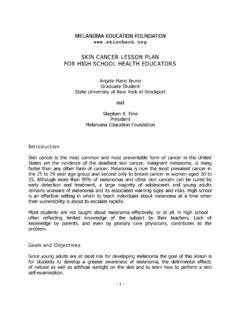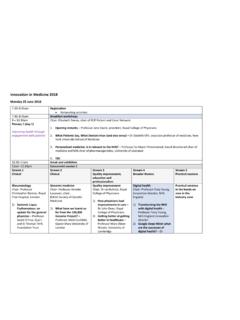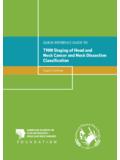Transcription of Evaluating school programmes.pd - World Health …
1 Evaluating SCHOOLPROGRAMMESTo Promote Sun ProtectionWORLD Health ORGANIZATION2003To Promote Sun ProtectionWORLD Health ORGANIZATIO2003 World Health organization 2003 All rights reserved. Publications of the World Health organization can be obtained from Marketing andDissemination, World Health organization , 20 Avenue Appia, 1211 Geneva 27, Switzerland (tel: +41 22 7912476; fax: +41 22 791 4857; email: Requests for permission to reproduce or translateWHO publications whether for sale or for noncommercial distribution should be addressed toPublications, at the above address (fax: +41 22 791 4806.))
2 Email: designations employed and the presentation of the material in this publication do not imply theexpression of any opinion whatsoever on the part of the World Health organization concerning the legalstatus of any country, territory, city or area or of its authorities, or concerning the delimitation of its frontiersor boundaries. Dotted lines on maps represent approximate border lines for which there may not yet be mention of specific companies or of certain manufacturers products does not imply that they areendorsed or recommended by the World Health organization in preference to others of a similar nature thatare not mentioned.
3 Errors and omissions excepted, the names of proprietary products are distinguishedby initial capital World Health organization does not warrant that the information contained in this publication iscomplete and correct and shall not be liable for any damages incurred as a result of its by Con Stamatis, The Cancer Council VictoriaPrinted in FranceAvailable at Library Cataloguing-in-Publication DataSun protection in schools: an educational package to protect children fromultraviolet : Sun protection and schools: how to make a difference -- Sunprotection: a primary teaching resource -- Evaluating school programmes topromote sun Sunlight - adverse effects 2.
4 Ultraviolet rays - adverse effects 3. Radiationinjuries - prevention and control 4. Radiation protection - methods 5. Schoolhealth services - organization and administration 6. Teaching 92 4 159062 9(NLM classification: WA 350)iiPreface .. ivSun Protection Programmes in Schools .. 1 What is Evaluation? .. 2 Why evaluate? .. 2 Who evaluates? .. 3 Types of Evaluation .. 4 Process evaluation .. 4 Outcome evaluation .. 4 How to Measure Change .. 5 Reporting Progress and Achievements .. 7 Conclusion .. 8 Further Information .. 9 CONTENTS iiiivOverexposure to ultraviolet (UV) radiation from thesun and artificial sources is of considerable publichealth concern.
5 It plays an important role in thedevelopment of skin cancer and eye damage(particularly cataracts), and suppresses the are particularly at risk as (i) sun exposureduring childhood and adolescence appears to set thestage for the development of both melanoma andnon-melanoma skin cancers in later life, (ii) asignificant part of a person s lifetime exposure occursbefore age 18, and (iii) children have more time todevelop diseases with long latency, more years of lifeto be lost, and more suffering to be endured as a resultof impaired efforts in schools to change children sknowledge, attitudes, and behaviour regarding sunprotection can significantly decrease adverse healtheffects and Health care worldwide participated in theInternational Workshop on Children s Sun ProtectionEducation,organized by the World HealthOrganization (WHO), held in Orvieto, Italy, on 4 October 2001.
6 Based on the outcomes of thisworkshop, WHO has developed a comprehensivepackage of materials for children s sun includes: Sun Protection and Schools: How to Make aDifference, which describes the importance ofsun protection in schools, and outlinesnecessary steps for establishing a schoolprogramme. Sun Protection: A Primary Teaching Resource,which is for primary school teachers andprovides suggestions and ready-made teachingactivities. Evaluating school Programmes to Promote SunProtection, which is for schools, and educationaland Health is critical to assess , this resource has been developed to assistthe implementation of school -based evaluationprogrammes relating to sun protection.
7 It is intendedto provide guidance, rather than be prescriptive, andto identify where further information can be document is intended primarily for teachers, school support staff, and allied Health workers at thelocal or district level who have had limited evaluationexperience but are required to oversee theimplementation of Health education and/or policy resource was prepared by Donna Cross,Curtin University of Technology, Australia, StephanieHarper, The Cancer Council Victoria, Australia, CraigSinclair, WHO, and Terry Slevin, Cancer Foundation ofWestern would like to thank the following individualswho offered substantial comments and suggestionsduring the International Workshop on Children s SunProtection Education and/or during the document sfinalization.
8 Anat Aizik, Israeli Cancer Association, IsraelCecilia Boldeman, Karolinska Hospital, SwedenPi rre C sarini, S curit Solaire, FranceAngus Fergusson, Meteorological Service ofCanada, CanadaRobin Fuchs-Young, University of Texas, UnitedStatesBeat Gerber, Swiss Federal Office of Public Health ,SwitzerlandSandra Gordon, Eastern Health and Social ServicesBoard, Northern IrelandKaren Glanz, University of HawaiiR diger Greinert, Dermatologisches ZentrumBuxtehude, GermanyDrusilla Hufford, Environmental Protection Agency,United StatesJack Jones, World Health organization , SwitzerlandGianni Mariutti, Istituto Superiore di Sanit , ItalyAmanda Marlin, World Health organization ,SwitzerlandJill Meara, National Radiological Protection Board,United KingdomIrena Miseviciene, Kaunas University of Medicine,LithuaniaDavid O Riordan, Boston University school ofMedicine, United StatesEva Rehfuess, World Health organization ,SwitzerlandMike Repacholi, World Health organization ,SwitzerlandUlrik Ringborg, Karolinska Hospital, SwedenColin Roy, Australian Radiation Protection andNuclear Safety Agency.
9 AustraliaMiguel Angel Santinelli-Ramos, Institute ofSecurity and Social Services for the State Workers,MexicoMona Saraiya, Centers for Disease Control, UnitedStatesSkaidra Valiukeviciene, Kaunas University ofMedicine, LithuaniaSUN PROTECTIONPROGRAMMES IN SCHOOLSA school programme to educate children about thedangers of sun exposure aims to increase knowledgeof the link between sun exposure and Health -relatedoutcomes, and to improve knowledge, attitudes, andskills in relation to sun protection in order to reducechildren s sun exposure. A sun protection programmecan also improve shade provision, or ensure that lessoutdoor activity is scheduled in the middle of the changes alone can significantly reduce studentsun , behaviour changes or modifications tothe school environment are more likely to occur whenthe rationale for these changes is understood by thewhole school community, and plans are in place tomonitor their effectiveness.
10 When such changes occur,children are likely to reduce their risk of skin cancerand eye damage (particularly cataracts) later in theiradult evaluate is to make a judgement about the value or worth of something. That judgement must be madeagainst an expectation based on past experience andrelate to what is important. Different people mightevaluate the same things in different Evaluating school -based sun protectionprogrammes, a teacher might evaluate a programmeaccording to the degree to which the programmeengaged and involved students, the level at whichstudents contributed to the programme , and theamount students learned from the project.













